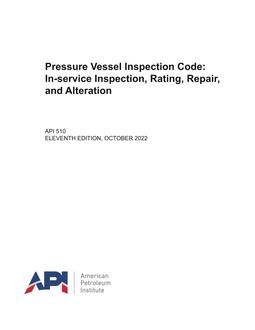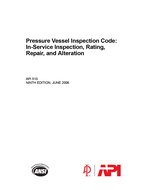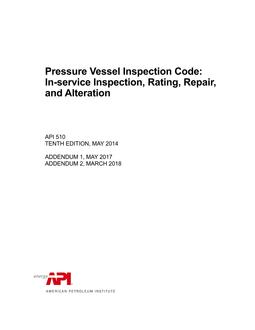This inspection code covers the in-service inspection, repair, alteration, and rerating activities for pressure vessels and the pressure-relieving devices (PRDs) protecting these vessels. This inspection code applies to all hydrocarbon and chemical process vessels that have been placed in service; however, it could also be applied to process vessels in other industries at owner-operator discretion. This includes:
a) vessels constructed in accordance with an applicable construction code [e.g., ASME Boiler and Pressure Vessel Code (BPVC)]; where a pressure vessel has been constructed to the American Society of Mechanical Engineers (ASME) Section VIII Code, API 510 is intended to apply to Divisions 1 and 2 and not Division 3;
b) vessels constructed without a construction code (noncode vessels);
c) vessels constructed and approved as jurisdictional special based upon jurisdiction acceptance of particular design, fabrication, inspection, testing, and installation;
d) nonstandard vessels.
However, vessels that have been officially decommissioned (i.e. no longer are an asset of record from a financial/accounting standpoint) are no longer covered by this “in-service inspection” code. Abandoned-in-place vessels may still need some amount of inspection and/or risk mitigation to assure they do not become a hazard because of continuing deterioration. Pressure vessels temporarily out of service and preserved for potential future use are still covered by this code.
The ASME Code and other recognized construction codes are written for new construction. Although most of the technical requirements for design, welding, nondestructive examination (NDE), and materials can be applied to the inspection, rerating, repair, and alteration of in-service pressure vessels, if for some reason an item that has been placed in service cannot follow the construction code because of its new construction orientation, API 510 rather than the construction code can be followed for the requirements for design, material, fabrication, and inspection. If in-service vessels are covered by requirements in the construction code and API 510 or if there is a conflict between the two codes, the requirements of API 510 take precedence.
API 510 does not cover source inspection of newly fabricated pressure vessels. Refer to API RP 588, Recommended Practice for Source Inspection and Quality Surveillance of Fixed Equipment, for guidance on the surveillance of supplier vendors fabricating and/or repairing pressure vessels that will be installed on site.
Product Details
- Edition:
- 11th
- Published:
- 10/01/2022
- Number of Pages:
- 83
- File Size:
- 1 file , 1.4 MB
- Product Code(s):
- C51011, C51011
- Note:
- This product is unavailable in Russia, Cuba, Syria, North Korea, Ukraine, Belarus, Iran



